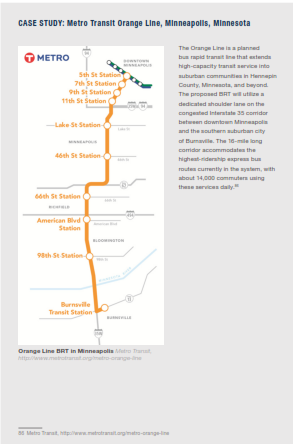On February 25, the NEOSCC Board will be voting on the the Vibrant NEO 2040 Vision, Framework and Action Products. Everyday over the next 5 weeks, we will be sharing an “Initiative A Day” so you can gain a better understanding of the vision and framework! If you would like to read all of the Initiatives, you can download them here Vibrant NEO Recommendation and Initiatives.
Show your support for Vibrant NEO 2040 by adding your name to our Champions of Vibrant NEO 2040 list here!
Initiative 5.2: Create a network of high-frequency express and local transit routes connecting the region’s job centers. Prioritize infill development in the corridors served by these routes. In the short and medium terms, upgrade high-performing existing bus routes and create new bus routes in designated corridors. In the long term, upgrade the highest-demand routes into commuter rail service.

WHAT THIS MEANS: Drawing on the approach of Initiative 5.1, this initiative calls for a focus on bus and rail routes that already carry high levels of ridership and serve critical connection needs within their communities, expanding the service on these routes and corridors to make transit a means of travel that is competitive with automobiles. Expansion of service means both increasing service frequency at key times of the day as well as extending the hours of the day that service is provided. In the case of inter-jurisdictional service coordination, this also means extending the length of service so that single routes are bounded by major origins and destinations—and not simply by political boundaries. It can also mean introducing express or limited-stop service between key destinations so that places with high concentrations of rider activity (such as major employment and shopping centers and university and college campuses) can be connected in shorter times. This also means investing strategically in relatively low-cost capital improvements—such as traffic signal infrastructure that gives priority to transit vehicles —that can improve the performance of transit service and offset the operational delays of frequent stops and starts that can come from high ridership demand.
WHY THIS IS IMPORTANT: Transit providers focus on high-performing routes and services to retain existing riders and attract new riders. They often prioritize service enhancements on these routes and strategic routes that connect to them so that transit becomes a more attractive and convenient travel option. When partnered with a regional approach to providing service between key activity centers (and focusing less strictly on adhering to county boundaries), many of these high-demand services can form the basis of a series of ‘trunk routes’ that orient transit service within a community and even throughout the region.
GETTING IT DONE: As in 5.1, this initiative must be led by transit operators with planning support as needed from the region’s MPOs. But whereas 5.1 focuses on service between major regional job and activity centers, this initiative involves recalibrating the county-level networks to optimize connections local and express services and a broader regional transit network. In this respect, initiative 5.2 should follow planning and institutional coordination work occurring in 5.1, and involve tighter collaborations between individual transit operators and MPOs.
BEST PRACTICE: The Greater Cleveland Regional Transit Authority completely refurbished 8.3 miles of historic Euclid Avenue as part of the Euclid Corridor Transportation Project, which opened fully in 2008. A bus rapid transit line, the HealthLine, now connects the central business district with major cultural, medical, and education users – all at one-fourth the cost of light rail. The transit project has helped catalyze $4.7 billion in spin-off investment and 11.4 million square feet of new and planned development, offering a successful example of the economic leverage potential for BRT. http://www.riderta.com/routes/HealthLine
http://www.rtahealthline.com/healthline-what-is.asp
| Lead | Transit Operators; Metropolitan Planning Organizations; Municipalities, Counties |
| Target Community | Strategic investment areas, asset risk areas |
| Implementation Complexity | Moderate |
These recommendations, initiatives, and products, are not one-size-fits all and some aspects of the initiatives won’t be applicable everywhere in the 12-county region. The Vibrant NEO 2040 Vision, Framework and Products are intended inspire and guide decision-making at the Metropolitan Planning Organization (MPO), Council of Government, and local levels to ensure that land use, transportation, and environmental considerations are simultaneously addressed by their processes. Ultimately, the implementation of Vibrant NEO 2040 is up to Northeast Ohio’s communities and residents. But regardless of the applicability of each initiative to any particular part of the region, the goal for each community within the Vision is the same: stability, prosperity, and a high quality of life for all of its residents.
